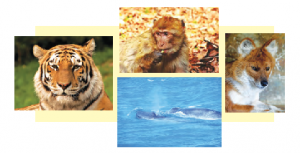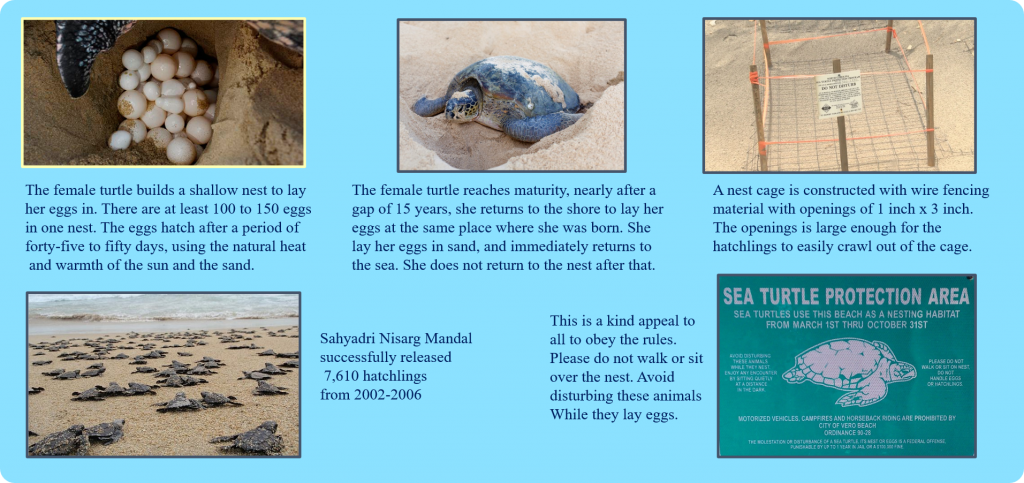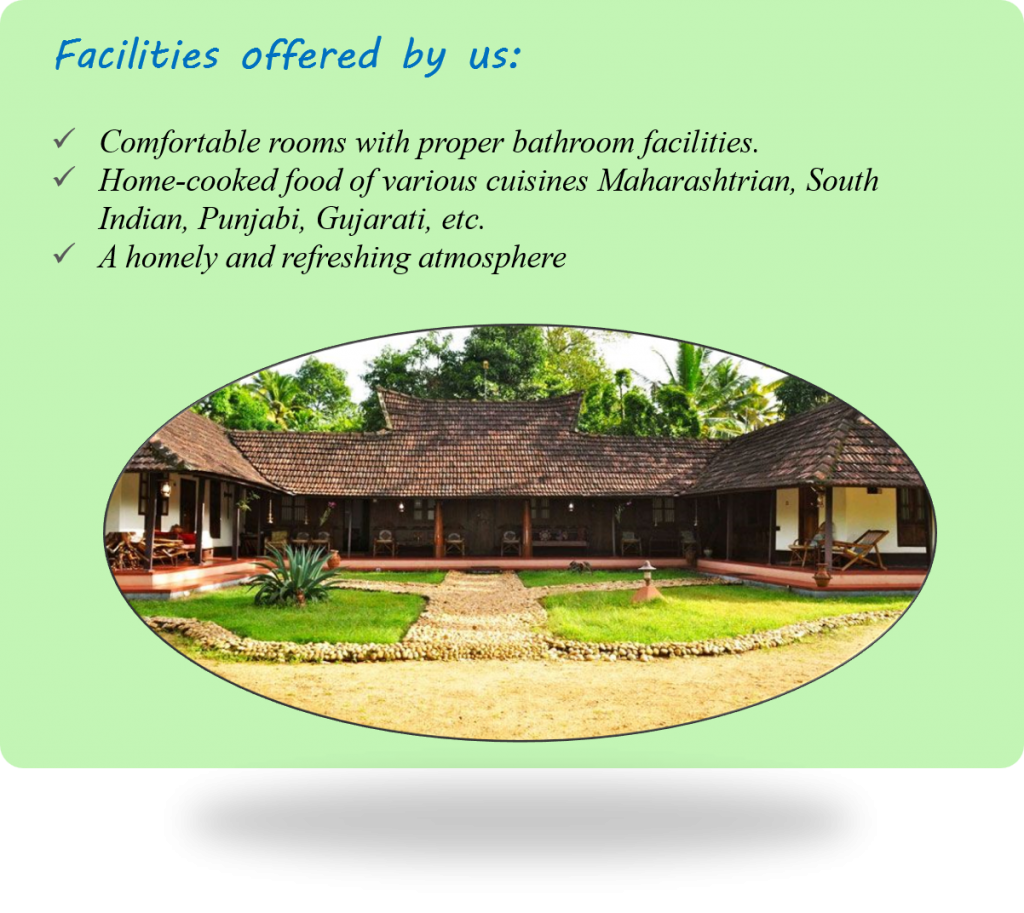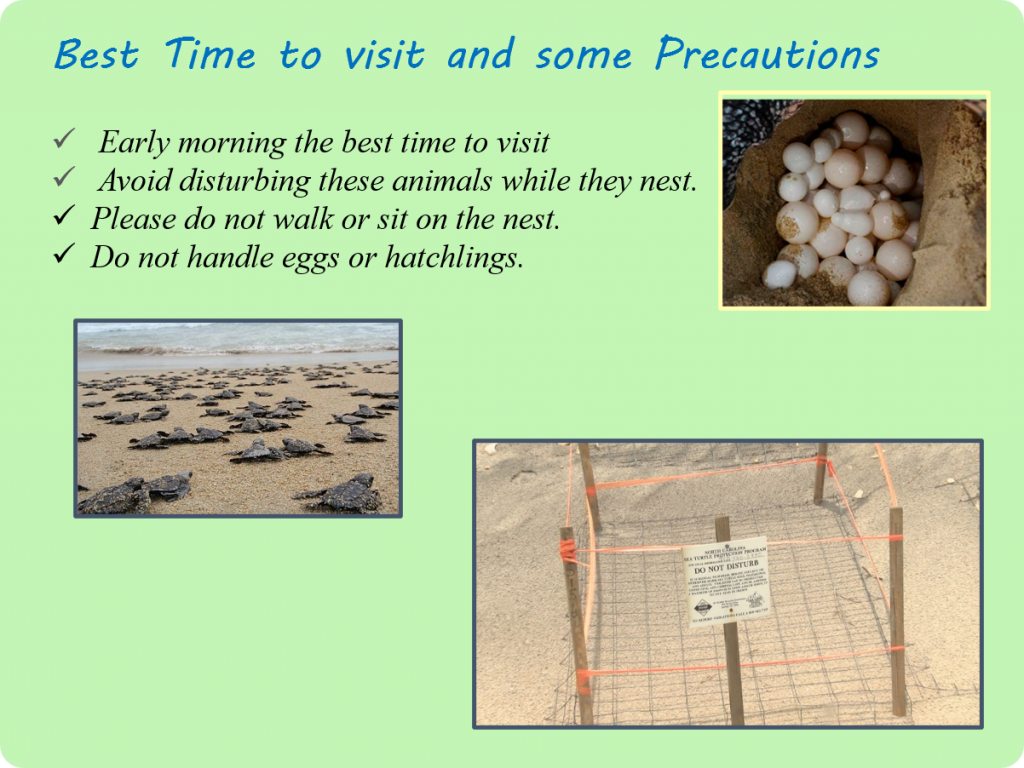… Warming Up …
It is our world, too!
1. Observe the following photographs. What is common among all these animals? They are all endangered species. They are likely to die out completely, one of the reasons being human activity in their habitat. If these animals could think and speak like humans, what would they say?

Form groups of 5-8. Prepare short autobiographical speeches for each of these animals (10-15 lines). Use the following points :
⇒ How the animal lives – It’s the only way he/she can
⇒ How he interacts with nature and other animals
⇒ How humans interact with that species – whether it is fair, necessary or desirable, etc.
⇒ The possible ill effects of the way human beings treat the animals, for the whole living world
⇒ The animal getting ready to bid farewell to this world
(1) Autobiography of a Tiger.
Ans. Hello, I am a Tiger. I live in the jungle, with my friends. I live here freely with no limits and no boundaries. Nature has bestowed us ample of land, water, etc. I use to prey mostly on animals like deer and buffaloes for living. But from last few years we are in trouble. Human beings hunt and kill us, they trap us and take us to cities. They keep us in cages, keep us hungry and use our skin as clothes, which is not fair. Due to there such actions I and all my friends use to attack human beings when found. We for the sake of our life attack human beings. We are near to extinct, if all of us die then where you will find such a heroic animals like us. I am worried that all of us will no more be a part of this world if this doesn’t stop. Please save us from this danger.
(2) Autobiography of a Monkey.
Ans. Hello, I am a Monkey. I live in the jungle, mountains, with my friends. I live here freely with no limits and no boundaries. Nature has bestowed us ample of land, trees, etc. I use to eat nuts, fruits, seeds and flowers. Some of my friends eat meat in the form of bird’s eggs, small lizards, insects and spiders. But from last few years we are in trouble. According to my knowledge 262 species of us in the world are threatened with extinction. Fifty-eight of the threatened species live in South and Central America, 46 in Asia and 26 in Africa. Of these, 24 species of us are critically endangered, with an extremely high chance of soon becoming extinct in the wild. Our young ones are mostly hunted my chimpanzees and rarely by Human beings. We are near to extinct, if all of us die then where you will find such a naughty animals like us who always entertain and tease you making you happy. Please save us from this danger.
(3) Autobiography of a Blue Whale
Ans. Hello, I am Blue whale the biggest animal in the world. I am a marine mammal and live freely with no limits and no boundaries. Nature has bestowed us ample of water bodies to live. I use to eat krill (euphausiids) and copepods. But from last few years we are in trouble. Humans hunt us extensively for our large quantities of baleen, blubber, and meat. We are near to extinct, if all of us die then where you will find such a big animals like us to show the world. Please save us from this danger.
(4) Autobiography of a Dhole.
Ans. Hello, I am ‘dhole’, or the Indian wild dog. I live in the mountainous regions. I am a social animal and live together with my whole family. I mostly hunt deer, monkeys, buffaloes etc. But from last few years we are in trouble. Human beings hunt us for fur. We are also dying due to diseases. Please save us from this danger.
2. Hold a classroom discussion on the following topics and later on, expand the themes on your own. (10-15 lines)
⇒ Why human beings need to use more and more natural resources.
⇒ Should we conserve only the most beautiful and most useful things in nature?
⇒ What is ‘beautiful’ or ‘useful’? Who has the right to decide that?
(a) Why human beings need to use more and more natural resources.
Ans. Due to increasing population human beings need to use more and more resources. But if this is not controlled then resources in future will decline and it will effect future generation peoples. So our duty is to conserve natural resource. We should use it in limited means. We should focus on renewable sources for generating energy. If the growing population is not controlled then whole world will face a dangerous situation. Non-renewable resources once gets depleted cannot be created since it takes many years to form. Every single person in this world should take the responsibility to conserve the natural resources.
(b) Should we conserve only the most beautiful and most useful things in nature?
Ans. It is right to say that we should conserve the most useful and most beautiful things in nature. But it is not 100% right to say like that. We should not think that in this big world only humans should exist and no other animals. We don’t know the fact that every organisms in this world is either useful for humans directly or indirectly. Most of the things in this world are not useful and not beautiful for humans but they in some way playing important role in maintaining our ecosystem balance and healthy.
(c) What is ‘beautiful’ or ‘useful’? Who has the right to decide that?
Ans. I think that if a person is well educated and is the lover of the nature then he/she has the right to decide what is ‘beautiful’ or ‘useful’. Else no one in this world has the right to decide that. As mentioned earlier that many things are not beautiful and useful in ones eye but it is useful in others eye.
… Factual Questions …
What unusual occurrence did the volunteers notice?
Ans. As volunteers roamed the coasts, one of the volunteers in their team saw some shallow pits with white egg shells nearby. Enquiries with the villagers revealed that they were turtle eggs. This came as a surprise. They had never come across turtle eggs in their walks along the beaches of Konkan in all the years. This was an unusual
occurrence.
Why were turtle eggs seen on the beach after it had been sealed to the public? What were the implications?
Ans. The beach was sealed to the public for nearly one month, so people could not access the eggs, and hence the volunteers saw the egg shells. The implications were that the turtle eggs were being stolen by the public when they had access to the beach.
Why have these turtles been protected in India?
Ans. Nearly all species of sea turtle are classified as endangered. If a turtle is spotted while it is still laying eggs, it is killed and eaten after it has finished laying the eggs. Also the eggs of the turtles are stolen by egg hunters. All these activity will end the turtles growth. Hence they have been protected in India.
Why were the people asked to look for the eggs or nests in the morning?
Ans. The people asked to look for the eggs or nests in the morning to prevent thefts.
The elderly persons had seen the hatchlings for the first time. What does it indicate?
Ans. The elderly persons had seen the hatchlings for the first time indicates that the theft of turtle eggs was so common that no eggs had been allowed to hatch for many years in the past.
Why was it necessary ton undertake turtle protection on a large scale?
Ans. The survival rate of the hatchlings is as low as just one or two turtles out of a thousand. Considering all these factors, it was necessary to undertake their protection on a large scale.
Why were those who had stolen the eggs earlier involved in the work of protection? Give at least two reasons.
Ans. (1) Those who had stolen the eggs earlier involved in the work of protection because they knew the exact details of where and when the turtles would lay their eggs. (2) The second reason was to give them a sense of responsibility.
What do the ‘homestay’ families do ?
Ans. The ‘homestay’ family give ten percent of their income to the Turtle Protection Fund.
Why was the project entrusted to the local people ?
Ans. Sahyadri Nisarg Mitra, believed that it is only the local villagers who can ultimately offer excellent protection to the local species. If they are given the freedom to do that, the conservation project can become sustainable. Hence, the project was entrusted to the local people.
…ENGLISH WORKSHOP…
1. Form groups. Discuss the first two paragraphs. Try to present their content in the form of a series of conversations among the (a) volunteers (b) the volunteers and the villagers.
(a) Conversations between volunteers
Ans.
First Volunteer : Hey look here, its like egg shells! I wonder how it is here?
Second Volunteer : Egg shells? Where? Oh its there deep in that pit in the sand!
Third Volunteer : I have never seen this before!
First Volunteer : Something unusual. We should ask these villagers.
Second Volunteer : They say that they are turtle egg shells.
Third Volunteer : But we had never come across turtle eggs in our walks along the beaches of Konkan in all these years.
First Volunteer : Let’s have detail enquiry about this from villagers.
Second Volunteer : That’s right.
Third Volunteer : Let’s go.
(b) Conversations between volunteers and villagers
First Villager : Ya, you are able to see this eggs these days because the beach was sealed for the public for nearly a month, after they had caught some people smuggling silver bricks in the area.
Third Volunteer : But, how is that related to the eggshells?
First Villager : Nowadays the local people come out early in the morning and search the beach for these eggs. They then either eat the eggs or sell them in the market.
Second Volunteer : That is so disturbing! How do they find these eggs?
Second Villager : The female turtle leaves a trail behind her after laying the eggs. The egg hunters follow this trail, dig up the pits, find hundred to one hundred and fifty eggs and then steal them.
First Volunteer : That is so wicked!
First Villager : Yes, it is, Sir. And if a female turtle is spotted while she is still laying her eggs, she is first allowed to lay her eggs and then, even she is caught and killed!
Third Volunteer : This is wrong and illegal! Sea turtles are given protection under the Schedule 1 of Indian Wildlife (Protection) Act 1972!
Second Volunteer : We need to take immediate action against this!
First Volunteer : Yes, we need to protect these turtles!
First Villager : We are ready to help in any way possible.
Third Volunteer : Let’s do this!
2. Prepare a short note on sea turtles with the help of the information given in the passage.
Ans.
Sea Turtles lay their nest along the coastline. They perform an important function in marine ecology. They keep the sea clean. There are seven types of sea turtles in the world. The Olive Ridley, Green turtles and Hawksbills this three species are a part of the Maharashtrian coastline. When the female turtle reaches maturity at the age of fifteen years, she comes out of the water and builds a shallow nest to lay her eggs in and leaves to never come back. There are at least hundred to one hundred fifty eggs in one nest. The eggs hatch after a period of forty-five to fifty days, using the natural heat and warmth of the sun and the sand. After hatching, these hatchlings rush to the water to go back to their homes in the sea. The survival rate is very low. Only one or two turtles survive out of thousands. Recently, their species have become endangered since the eggs are often stolen and then eaten or sold in the market. Thus, it has become ecessary to protect these turtles.
3. Prepare a poster to illustrate how the turtle eggs were/are protected. Include the following in the poster.
⇒ Some pictures of sea turtles and their habitat
⇒ Information about turtle nests and eggs
⇒ A picture and information about a ‘protected nest’
⇒ Appeal to the public to spread awareness about their conservation
⇒ Some data (figures) regarding the achievements so far
Ans.

4. Prepare a simple brochure regarding the ‘homestay’ facilities made available in the villages. Form groups and discuss the points you will use in the brochure. Remember to include the precautions that tourists have to take at the site, in your brochure.
Ans.



5. Explain the idea of ‘Conservation of Nature through Livelihood’ briefly, using the example given here.
Ans. The idea of ‘Conservation of Nature through Livelihood’ explains that both livelihood and conservation of nature can go simultaneously. The villagers of Velas have become a part of the ‘Turtle Friends Club’. They have ‘homestay’ facilities at their houses, so that the tourists who come to take part in the Turtle Festival can stay there. Through this, they get a handsome income. They know that they can earn unlimited if tourist keep visiting here to see turtles world. So they started to protect turtles from any harm. This is how the idea of ‘Conservation of Nature through Livelihood’ works. Thus in exchange for income, people started Protecting nature.
6. Prepare bullet point presentations on the following:
(a) Scope for tourism in your locality
(b) Prudent utilisation of natural resources
Ans.
(a) Scope for tourism in your locality
- SHIVGAD – FORT ON THE COAST OF MAHARASHTRA
Shivgad is a small town in Sindhudurg district in Maharashtra, India. - MSRTC buses, Private Buses, & taxies from Mumbai (458km).
- Places worth seeing – Shivgad fort, Sinhagad fort, Kali temple, Vyaghreshwar waterfall, Dajipur sanctuary & beaches etc.
- Best time to visit shivagad is winter season
(b) Prudent utilization of natural resources
- Natural Resources are limited, it includes water, oil, wood, etc.
- The better and more efficiently we utilize them, the better it would be for the country.
- Some natural resources can be renewable
- The non-renewable resources include oil, minerals, and soil.
- Non-renewable resources take years to get replenished, thus judicious use is necessary.
- Over-usage of any resource is harmful for the environment.
7. Read the following entries in the ‘Language Study’ pages :
(a) clause (b) sentence
Underline the main clause in the following sentences.
(1) There are a few people in every village who keep combing the beach in the early hours of the morning, throughout the year.
(2) When the female turtle comes on shore to nest and to lay eggs, she leaves behind a trail just like a track of wheels on the sand.
(3) The egg hunters follow this trail right up to the nest which is about half a metre deep.
Ans.
(1) There are a few people in every village who keep combing the beach in the early hours of the morning, throughout the year.
(2) When the female turtle comes on shore to nest and to lay eggs, she leaves behind a trail just like a track of wheels on the sand.
(3) The egg hunters follow this trail right up to the nest which is about half a metre deep.